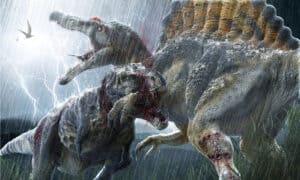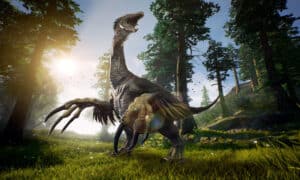The term “Thyreophora” means “shield bearers”, which is an apt description for this group of fascinating dinosaurs. Thyreophorans, or “armored dinosaurs”, are a group of mostly plant-eating dinosaurs that are distinguished by their unique body armor. They lived all over the world beginning in the early Jurassic Period, with some living all the way through the end of the Cretaceous Period. The most famous of these dinosaurs are probably the Stegosaurus and the Ankylosaurus, but there are many, many more! So, let’s take a closer look at some of the incredible thyreophorans!
The Three Groups of Thyreophora
There are three main groups of thyreophorans: Basal thyreophorans, Ankylosauria, and Stegosauria.
Basal thyreophorans are the earliest known dinosaurs in this group and only lived during the Jurassic period. These dinosaurs were small to medium in size and had more primitive plates—they looked much different than say, the heavily-armored ankylosaurus. In fact, some of these early basal thyreophorans even walked on their hind legs!
Ankylosaurians were stocky dinosaurs with heavy armor covering their bodies head to tail—some even had body armor on their eyelids! Dinosaurs like the ankylosaurus had distended vertebrae that was fused into a heavy tail club, while others had sharp spines, spikes, and bony bumps.
The third group, Stegosauria, lived mostly during the middle or late Jurassic period. These thyreophorans had very small heads and rows of large plates and/or spikes running along the middle of their backs.
1. Scutellosaurus

Scutellosaurus dinosaurs had heavy armored plating on their bodies.
©Catmando/Shutterstock.com
The earliest known thyreophoran dinosaur with armor is the Scutellosaurus. These dinosaurs lived during the early Jurassic Period in Arizona, around 196 million years ago. Unlike many of the later thyreophorans, the scutellosaurus was much smaller, growing only around 4-5 feet long and weighing only 22 pounds. It may have even walked on its hind legs! This dinosaur had a very long and slender tail, possibly to help counterbalance the weight of its armored body. The scutellosaurus had several rows of small bony plates fixed in the skin on its back.
2. Emausaurus
Another Basal Thyreophoran is the Emausaurus, an armored dinosaur that lived in Germany during the Early Jurassic Period. Its name is actually an acronym for “Ernst-Moritz-Arndt-Universität”, a university in Germany. There are debates as to the size of Emausaurus, which was could have been anywhere between 7-13 feet long and 110-530 pounds. However, we do know that Emausaurus had bony plates in its skin that helped it to defend against predators.
3. Scelidosaurus
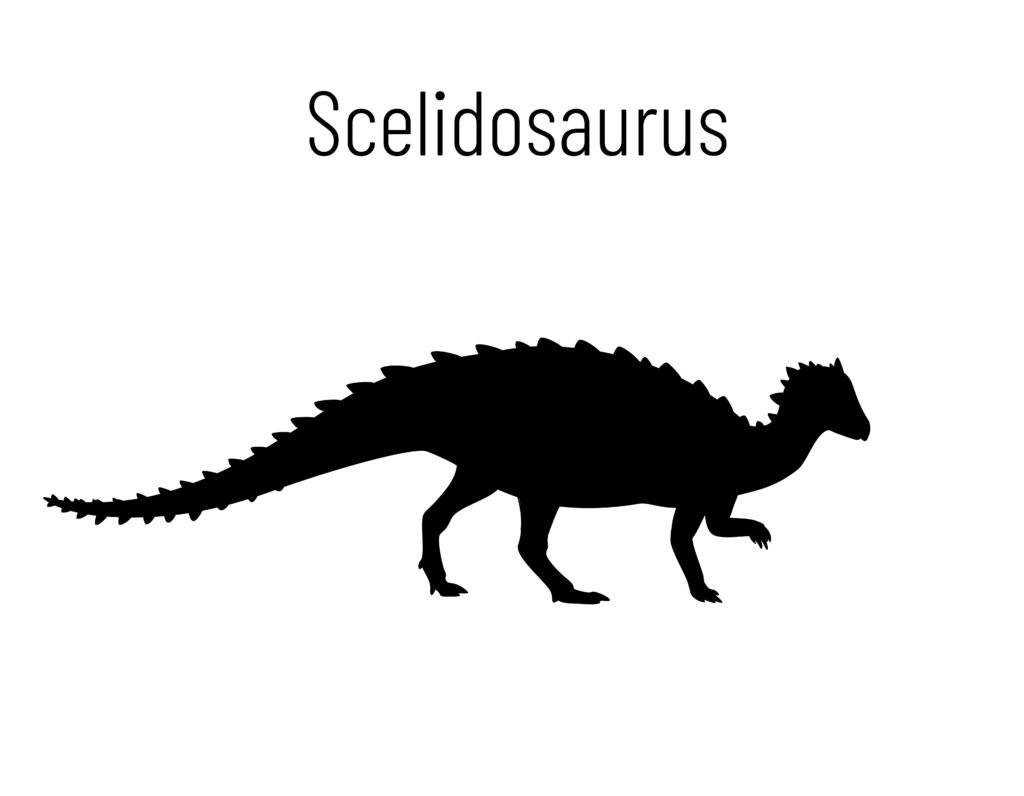
Scelidosaurus had bony plates along its back.
©tinkivinki/Shutterstock.com
Found in western Europe just over 180 million years ago, the Scelidosaurus was another smallish-to-medium-sized basal thyreophoran dinosaur with armor that grew 13 feet long and stood just over 3 feet tall. As cool as this dinosaur is, however, paleontologists didn’t discover it until 1980! Scelidosaurus was discovered in the British Isles and is estimated to have lived around 191 million years ago. As one of the older thyreophoran dinosaurs, scelidosaurus was only lightly armored, with rows of protective oval scutes stretching along its neck, back, and tail.
4. Chialingosaurus
One of the more slender-bodied thyreophoran dinosaur with armor is the Chialingosaurus, a stegosaurian that grew around 13 feet long. Its name comes from the Chialing River in southern China, where the fossils were first discovered in 1957. The Chialingosaurus lived during the middle of the Jurassic Period, around 160 million years ago. Some paleontologists think that the upper portions of the dinosaur were covered with armored plates, while the hips and tail had spines.
5. Kentrosaurus
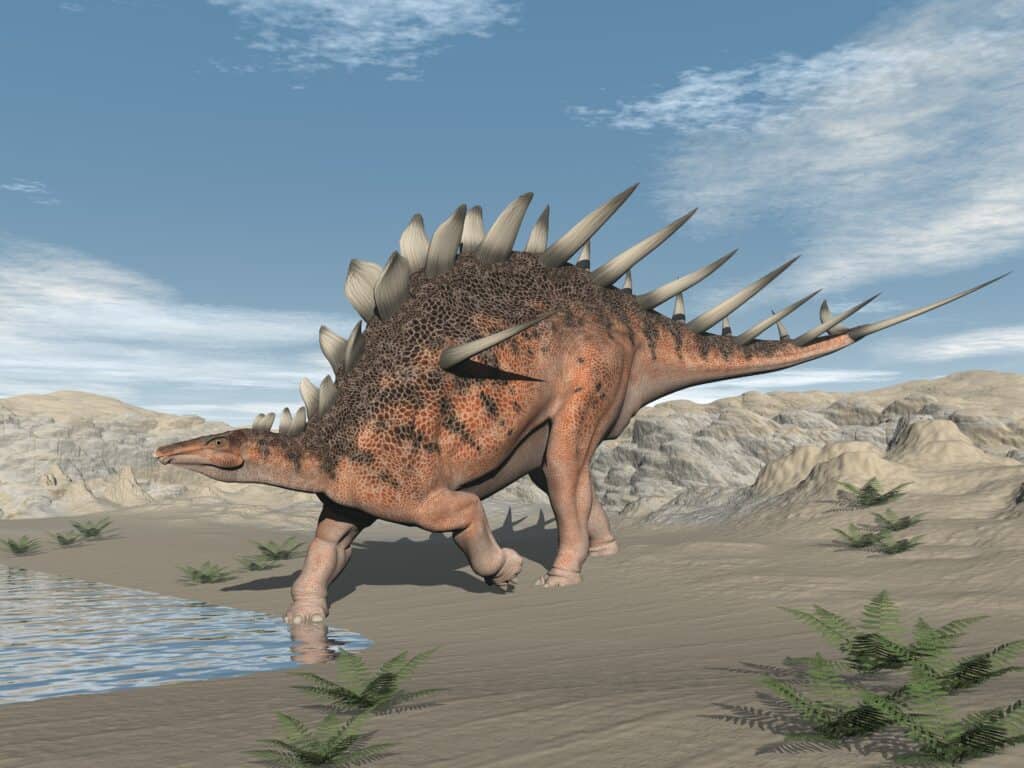
Kentrosaurus had incredible armor on its body in the form of large spikes.
©Elenarts/Shutterstock.com
There were many thyreophorans during the late Jurassic Period, including the incredibly spiky Kentrosaurus. This stegosaurian dinosaur lived around 152 million years ago in Tanzania. It grew around 15 feet long and weighed around 1 ton, with a double row of small plates covering its neck and down its back. When the plates reached the dinosaur’s hips, they merged into larger spikes that covered its hips and tail. The Kentrosaurus used the large spikes at the end of its tail to defend itself from predators. What’s really neat about the Kentrosaurus, however, is that it had unusually long spikes on each of its shoulders.
6. Gigantspinosaurus
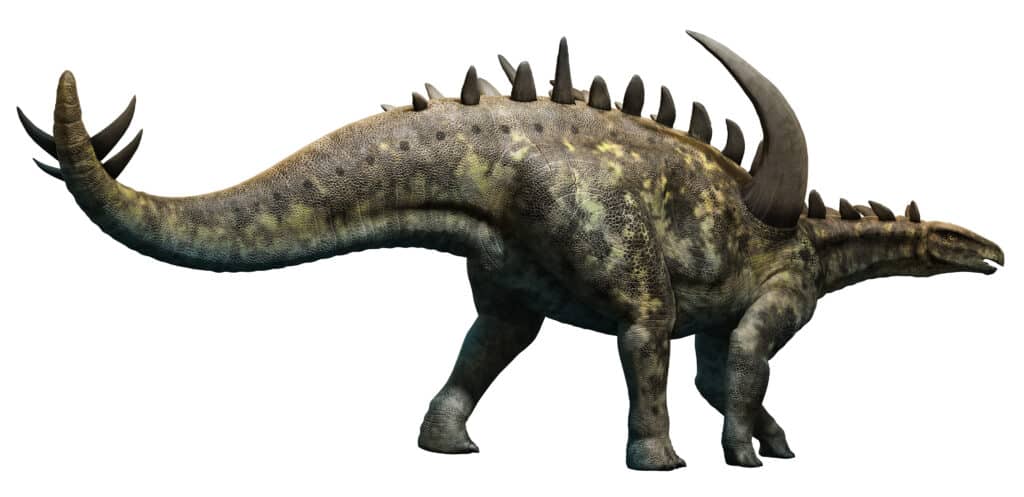
Gigantspinosaurus was named for the large spines protruding from its shoulders.
©Warpaint/Shutterstock.com
While its name may suggest a very large dinosaur, the Gigantspinosaurus was only around 14 feet long and weighed 1,500 pounds—not a small dinosaur of course, but certainly not the largest on this list. “Gigantspinosaurus”, which means “giant-spined lizard”, actually refers to the massive spines that protrude from each of the dinosaur’s shoulders. These oversized shoulder spines are certainly big enough to act as a defense, but they likely were there for display. This stegosaurian dinosaur also had other smaller spines and plates on its body that provided sufficient defense.
7. Stegosaurus
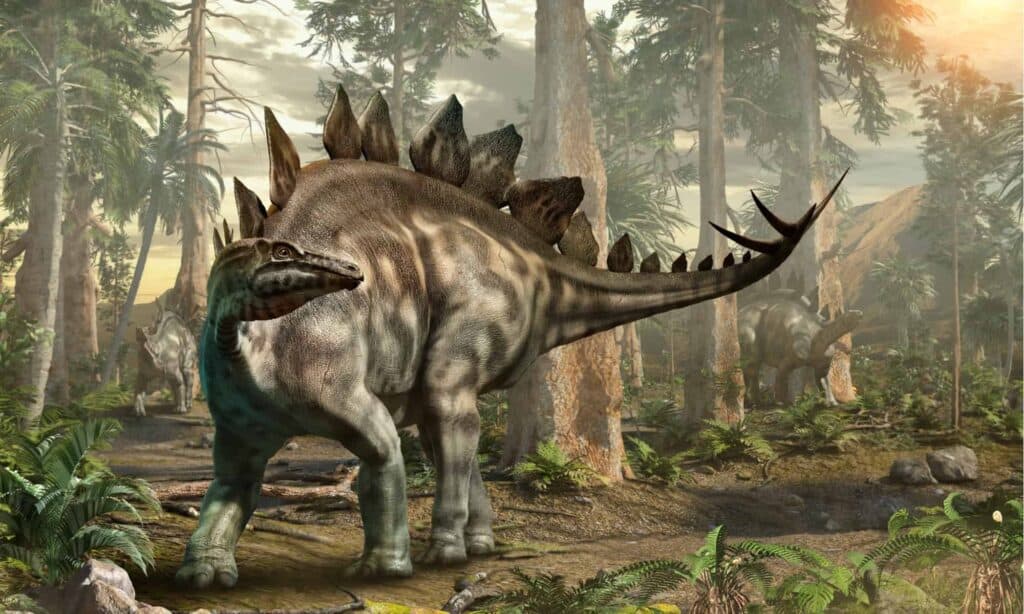
One of the most well-known thyreophoran dinosaurs with armor.
©Warpaint/Shutterstock.com
One of the most famous thyreophorans out there is the iconic Stegosaurus. Its name doesn’t seem to fit this iconic dinosaur, since it means “roofed lizard”. That is because it was named back in the 19th century, when paleontologists thought that its plates laid flat and horizontal against its back.
Today, however, research suggests that its large, triangular-shaped plates running down its neck and back in alternate in rows with the pointy ends facing up to towards the sky, before ending in its spiked tail. Even though the stegosaurus is quite large—around 23 feet long and weighing 4.2 tons—it is famous for having a tiny brain.
8. Tuojiangosaurus
One of the most well-known and best understood thyreophorans from China is the Tuojiangosaurus. This large stegosaurian dinosaur was around 21 feet long and weighed 3.1 tons. While it looked somewhat like the stegosaurus, it had a double row of pointed plates ran along the tuojiangosaurus’s back. Its head was low and also narrower, while its body was large and bulky. The Tuojiangosaurus lived during the late Jurassic Period.
9. Euoplocephalus
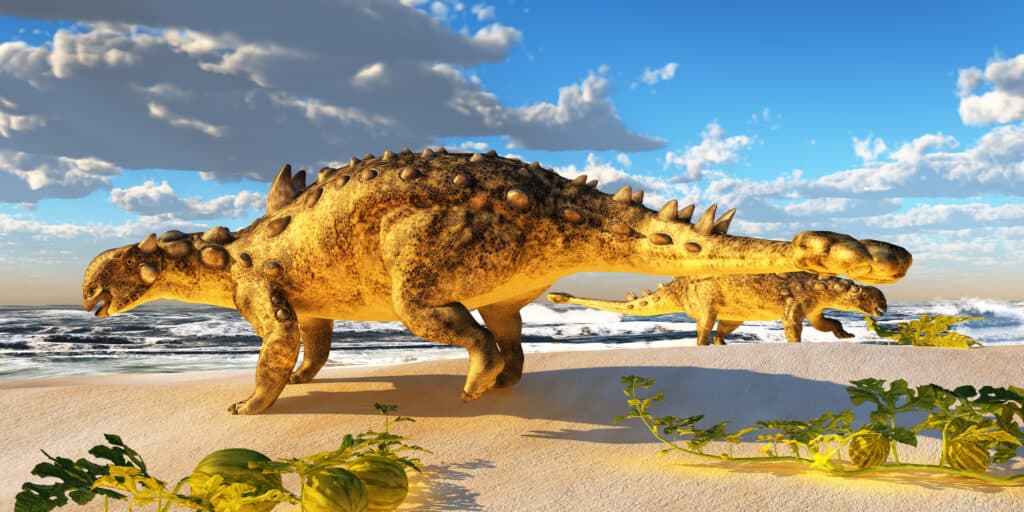
Euoplocephalus had heavy armor on its body and a club-like tail.
©Catmando/Shutterstock.com
One of the later thyreophorans is the Euoplocephalus, an ankylosaurid dinosaur that lived around 70 million years ago during the Late Cretaceous Period. It was 16-20 feet long and weighed over 2 tons. It had a wide, heavy body that was close to the ground, and a heavy club-like tail. The Euoplocephalus was discovered in Canada in 1897, and its name means “well-armored head”. Like other thyreophorans, the euoplocephalus looks tough, but ate plants using its horny beak-like snout to break off the leaves and stems.
10. Ankylosaurus
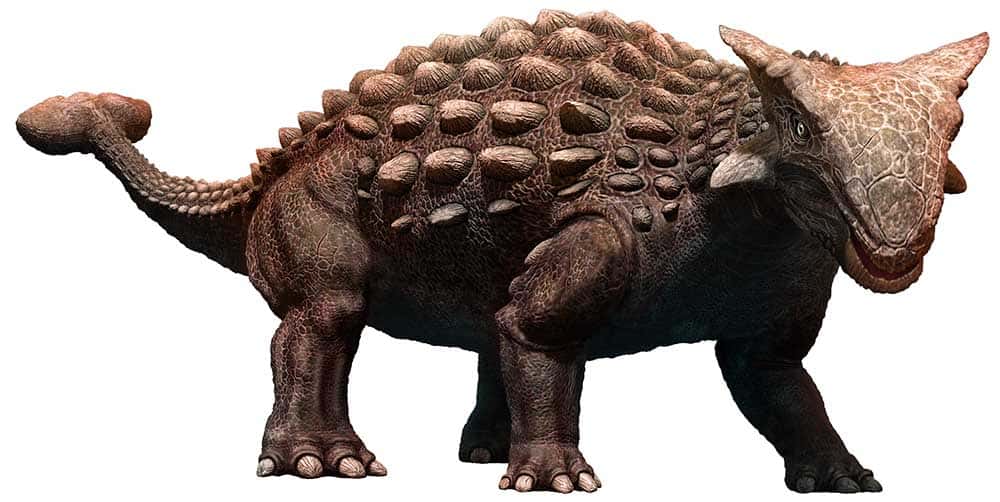
Ankylosaurus grew to around 20 feet long and had a large, wide head.
©Warpaint/Shutterstock.com
One of the last non-avian dinosaurs on the planet was the famous Ankylosaurus, a large dinosaur that grew around 20.5 feet long and weighed up to 13,000 pounds! The ankylosaurus lived in western North America around 68-66 million years ago, during the end of the Cretaceous Period. This dinosaur had a large and wide skull, with horns pointing back and down from the back of its head. The largest ankylosaurus skull discovered so far measured over 2 feet long and 2 feet wide!
Its skull and other parts of the ankylosaurus’s body were fused, reinforcing and increasing its overall strength. The end of its tail was also fused, forming a large, weapon-like club. Its neck, back, and sides were covered with bony plates, knobs, and scutes embedded in its skin, giving this iconic thyreophoran a dangerous and formidable appearance.
The photo featured at the top of this post is © Warpaint/Shutterstock.com
Sources
- Paleontology World, Available here: https://paleontologyworld.com/dinosaurs-%E2%80%93-species-encycolpedia-curiosities/thyreophora-armored-dinosaurs
- Berkeley, Available here: https://ucmp.berkeley.edu/diapsids/ornithischia/thyreophora.html
Thank you for reading! Have some feedback for us? Contact the AZ Animals editorial team.



